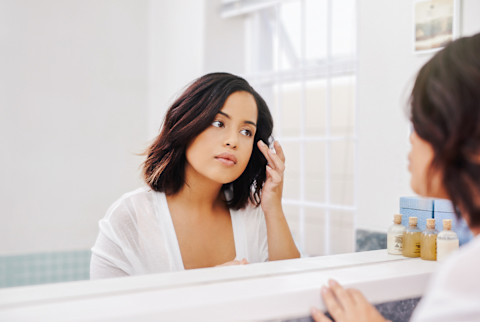Heat Makes Your Melasma Worse, A Derm Explains + What To Do About It

Pigmentation issues routinely hover at the top of the list of skin concerns for many—they may start in your teen years, as acne gives way to darker red and brown patches of post-inflammatory hyperpigmentation. Or maybe you even notice sunspots in your late 20s, creeping in from UV damage of years past. Finally, you may find you suffer from melasma, a condition characterized by dark brown or gray-brown patches of melasma appearing most often on the cheeks, forehead, nose, and chin. It can affect any skin tone, and it usually starts affecting people around their 30s and 40s, progressively getting worse over time.
If you have melasma, you likely know how tricky it can be to tend to—and thus preventive care is often key. Essentially, if you avoid common triggers that make it worse, you don't have to deal with trying to brighten your tone later.
Generally, the most commonly understood triggers are hormonal changes and UV damage. Hormonal changes are often out of our control—for example, women tend to get melasma worse during pregnancy—but you can certainly avoid sun damage. We advise everyone to wear SPF, but those with melasma especially need to heed these warnings.
But there's another trigger—that may actually get worse in the winter—from a very unexpected source.
High heat sources can make melasma worse.
OK, first up: High heat and winter don't usually go in the same breath. But during the winter, many utilize space heaters and other forms of intense heat indoors to stay warm. Having a concentration of the heat on your skin for extended periods of time could make your melasma worse, explains board-certified dermatologist Whitney Bowe, M.D.
"If you have melasma, then you want to avoid any sources of heat—whether it's getting too close to the oven, hot yoga, infrared saunas, blow dryers, and space heaters. These are really bad for melasma," says Bowe.
If you do all that you can to attend to your melasma, and you can't figure out why it's getting worse, start looking for your common heat sources. If you use heat lamps and space heaters (likely more prominent now that we are encouraged to eat outdoors), don't spend too much time in super-close contact. If you use a blow dryer every day, consider switching to low heat, which is better for your hair anyway. Opt out of infrared saunas, if you are one to typically frequent them. Consider switching from extra-hot workout classes to standard ones. Some lifestyle changes, like say cooking, aren't as easy, but just be mindful while you're in the kitchen, and do the best you can.
As for topical treatments, arbutin is a safe, natural brightener. "Arbutin is a naturally occurring compound in the leaves of a variety of plants, including pear trees and the bearberry plant, that prevents the formation of melanin," says board-certified dermatologist Keira Barr, M.D., noting that the overproduction of melanin in certain areas is what makes up dark spots and melasma patches. "It functions as a tyrosinase inhibitor to provide skin-brightening effects. This happens because when your skin and these cells come in contact with UV light or intense heat, the tyrosinase enzyme is activated. Arbutin blocks this."
The takeaway.
Melasma is a tricky skin condition that can cause patches of discoloration on skin. The most commonly understood causes are hormones (hard to control) and UV damage (much easier with smart sun care). However, a third common trigger—heat—may be the source of your issues, especially in the winter when many use space heaters, heat lamps, and other sources of concentrated heat.
